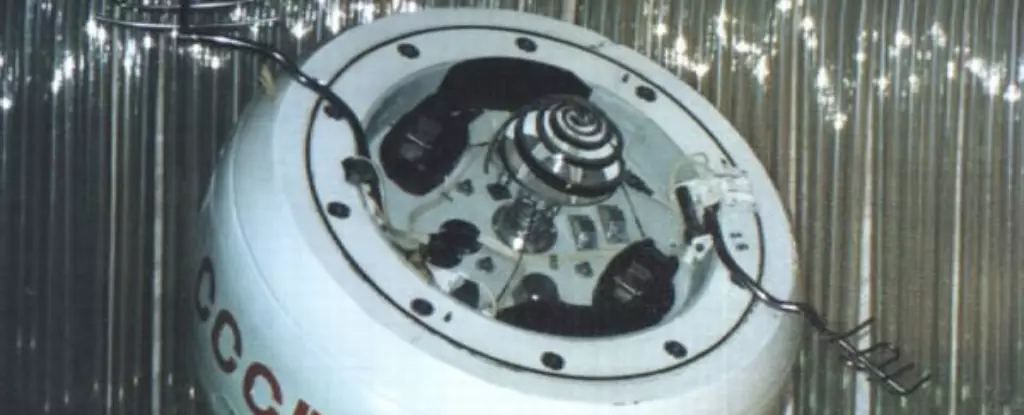Launched in 1972, Kosmos-482 embodies an era of ambition, secrecy, and the relentless pursuit of extraterrestrial exploration during the Cold War. This mission—originally slated for a journey toward Venus—never fulfilled its intended purpose, but rather serves as a poignant reminder of the tumultuous yet exhilarating nature of space exploration. As Kosmos-482 braces for reentry into Earth’s atmosphere, it symbolizes not merely a mechanical relic, but a narrative woven into the tapestry of human endeavor and the often-overlooked triumphs and tragedies of space missions.
This ancient spacecraft, which has drifted silently above our planet for over half a century, is set to meet its fiery fate. The trajectory and timeline of this spacecraft’s journey—characterized by both its ambitious beginnings and its chaotic downfall—offer insights into the shadowy contours of the Soviet space program’s history, a landscape littered with unanswered questions and stubborn myths.
Cold War Shadows: The Soviet Space Program
The mid-20th century was a time of great tension, with the Space Race standing as a hallmark of technological rivalry. Launching from the Baikonur Cosmodrome in Kazakhstan on March 31, 1972, Kosmos-482 was representative of the Soviet Union’s covert ambitions. The mission appears to have experienced a crucial failure that prevented it from initiating its voyage to Venus, leaving it to languish in orbit instead.
Kosmos-482’s mission designation remained a mystery, largely because the Soviet government maintained a veil of secrecy around its failed endeavors. The lack of transparency, combined with the Cold War’s inherent competitive spirit, shaped a narrative that has left historians and enthusiasts alike speculating about its intended goals. The common acknowledgment of its malfunction hints at an operational environment where the stakes were astronomically high and the consequences of failure could resonate profoundly on a political level.
The Legacy of Failures: A Broader Context
Kosmos-482’s demise follows a lineage of failures that echo through the annals of space exploration, particularly evident in subsequent Soviet missions. The 2012 Phobos-Grunt mission, which also failed to reach its objectives, serves as a modern parallel to the earlier endeavor, highlighting systemic issues within the Russian space program. What’s particularly galling is that while the Soviet Venera missions made significant strides toward advancing our understanding of Venus, the post-Soviet era has struggled to replicate this level of success in planetary exploration.
The fate of Kosmos-482 beckons us to reflect on our relationship with technology and our responsibility to understand and address failure as part of our exploratory spirit. Indeed, it serves as a reminder that even in the face of grand ambition, human ingenuity is often at odds with the unpredictable nature of the universe.
The Reentry: Anticipation and Speculation
As Kosmos-482 prepares to return to Earth, its uncontrolled reentry poses little risk to those below. Weighing in at 500 kg—about as heavy as a small car—its descent is being closely monitored by satellite observers like Marco Langbroek, who suggest that it may survive its passage through the atmosphere, thanks to its original design as a lander intended to withstand extreme conditions on Venus. These speculative musings add a layer of drama to an already intriguing story, inviting us to witness a collision of history and modernity as a tangible artifact of our cosmic pursuits ends its journey.
The gravitational pull of curiosity keeps enthusiasts and astronomers entranced by the celestial events, with predictions for its reentry being closely tracked. The reentry window spans a vast swath of latitude from 52 degrees North to 52 degrees South, which adds an element of unpredictability to the final chapter of Kosmos-482’s story. Each pass is a silent reminder that while the chaos of orbital debris continues to escalate, we are still captivated by the stories these remnants tell.
A Crowded Cosmic Stage
The ongoing growth of satellite launches into low Earth orbit—exemplified by megaconstellations from SpaceX, Amazon, and others—proposes a mixed legacy for the future of space exploration, particularly as the influx of technology rivals the poignant stories of missions long past. As spacecraft like Kosmos-482 make their final descent, they contend not only with the atmosphere but also with a legacy of myriad satellites that prompt the need for responsible stewardship of our orbital environment.
With the prospect of witnessing Kosmos-482’s reentry in the coming weeks, the call to recognize these artifacts of human ambition and folly has never been more critical. Each orbital remnant, each future launch, serves as a chapter in our collective quest. As we look up toward the sky, we are left to ponder the interactions between our aspirations and the cosmos, forever intertwined in a dance of dreams, failures, and newfound beginnings.

